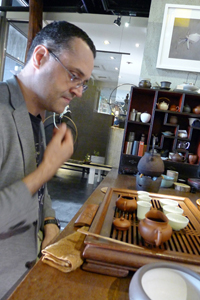Prof. Miguel Cazalilla (Department of Physics, National Tsing Hua University, also a Center Scientist in NCTS) initiated a collaboration with a team of three other theorists published in the journal Physical Review of the American Physical Society (APS) [1]. They developed a model to unveil a mechanism by which the small force induced by the metal clusters on the electron spin (technically known as “spin-orbit coupling”) can be amplified by the resonant scattering of the electrons with the residual copper clusters. Their model was confronted with the experimental data obtained by Prof. Barbaros’ group, showing that it can account for the experimental data of both the conductivity of the device and the ratio of the produced spin current to the total current (technically known as spin Hall angle). Their joint results have recently appeared in the journal Nature Communications [2]. Further more, in a recent work published in Physical Review Letters [3], they explain how, by the physical application of strain and/or by placing a single TMDC layer like MoS2 on an insulating 2D material like Boron Nitride, such an insulating crystals can be turned into materials that exhibit a robust QSHE.

REFERENCES
[1] Extrinsic Spin Hall Effect Induced by Resonant Skew Scattering in Graphene
A. Ferreira, T. G. Rappoport, M. A. Cazalilla, and A. H. Castro-Neto,
Phys. Rev. Lett. 112, 066601 (2014).
[2] J. Balakrishnan, G.-K. Wai Koon, A. Avsar, Y. Ho, J. H. Lee, M. Jaiswal, S.-J. Baeck,
J.-H. Ahn, Aires Ferreira, M. A. Cazalilla, A. H. Castro-Neto, and B. Ozyilmaz,
Nature Communications 5, 4748 (2014)
[3] M. A. Cazalilla, H. Ochoa, and F. Guinea Phys. Rev. Lett. 113, 077201 (2014).



